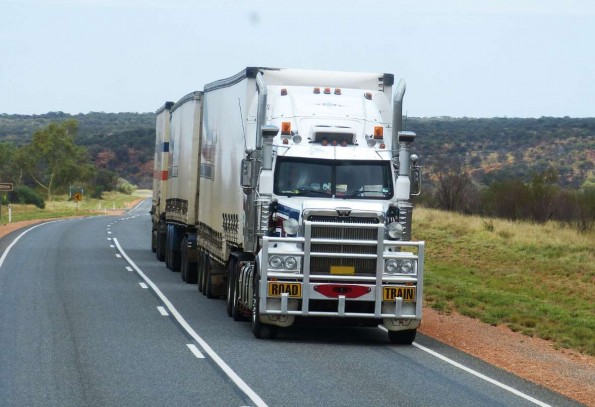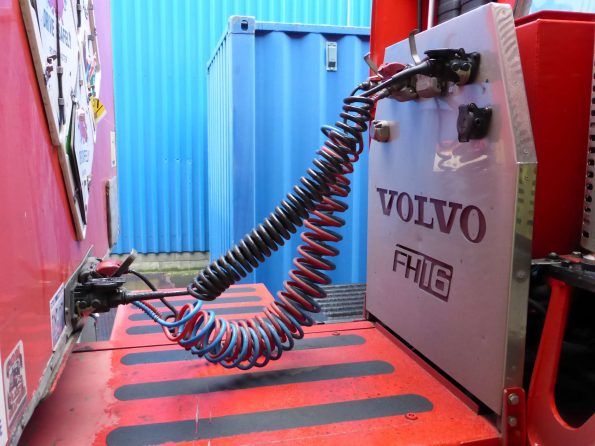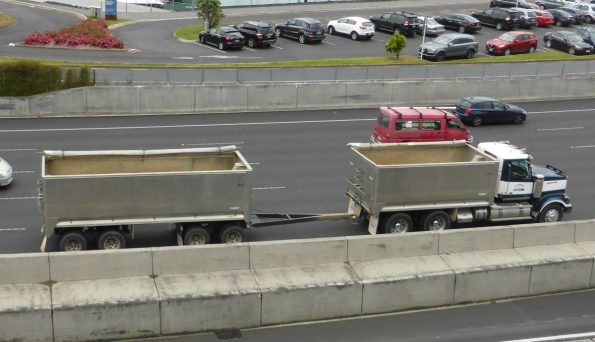If you want to get an advantage over your competitors, fuel economy is one way to do it. Even simple changes can make big differences.
Improve aerodynamics and rolling resistance
Aerodynamics: making the truck more slippery
Trucks have a huge cross section: they have to push a lot of air out of the way. Around 21% of your fuel is used just resisting air. If you’ve flown a kite then you know how much force there can be even if the wind is only gusting 30km/h. Now multiply that by up to the size of the front of your truck, and triple the wind speed.

This road train has a roof-top air deflector and the curtain sides are tight
There are ways of making trucks more aerodynamic:
- Aerodynamic aids such as roof-top air deflectors, cab side edge turning vanes, front fairings, trailer side skirts and under-bumper air dams
- If you have a sliding fifth-wheel coupling, keep the trailer as close as you can to the tractor
- Sheet your empty tipper bodies – this can save 8% alone!
- If you’re using a flat bed, load it in the most aerodynamic way possible, without overloading axle weight limits
- Keep curtain-side bodies and trailers taught so there’s no luffing or flapping in the wind
- Buy the right trailer – don’t buy a trailer that’s taller than you need otherwise you’re just pushing more air than is necessary
- Choose a truck with aerodynamic features
- Remove unnecessary adornments on your truck like air horns.

Keeping the distance between the tractor cab and the trailer to a minimum reduces drag

Lazy driver didn’t bother sheeting these empty trailers meaning fuel economy is worse
Tyres
If you can use low rolling resistance tyres then you can make some fuel savings – generally a couple of percent – but if you let your tyres go flat by 10psi then you easily lose 1%. Plus, flat tyres heat up and degrade more quickly and are at greater risk of blowout. If you over-inflate your tyres you will reduce rolling resistance, you will wear them out more quickly in the centre and it reduces grip.
Use the cold pressure inflation guidelines set by the tyre manufacturer.
Wheels
The alignment of your wheels affects how much resistance there is. Wheels that are misaligned create extra friction on the road, wearing your tyres out more quickly and causing the engine to have to work harder.
Misaligned wheels on a trailer will cause the trailer to crab slightly sideways, increasing wind resistance, too.
Loads
Are you carrying around items that you don’t need to carry? Any extra weight causes extra fuel consumption. Estimates are for every 1000kg you’ll use 1% more fuel, although this varies per truck type and manufacturer.
Maintain your momentum
Starting your truck from a standstill uses more fuel than if it’s already moving, even at just a couple of km/h. When you are travelling in heavy traffic, adjust the gap between your truck and the vehicle in front so that you can smooth out the stops and starts of rush hour traffic. Even if you just maintain a walking pace you will reap fuel economy benefits.
When approaching an intersection where you might need to stop, like a roundabout or traffic lights, try to adjust your arrival where there’ll be a gap (at a roundabout) or a green light. Green lights in the distance probably means it’ll be red by the time you get there, therefore you can ease off the throttle and let the engine do some of the braking. You might still have to stop, but you haven’t burned any more fuel than is necessary arriving there.
Practice smooth lines around the corners so that you can maintain a slightly higher average speed. Improving your average corner speed by just a couple of kilometers per hour will save your brakes and reduce the amount of fuel used accelerating. Don’t risk a rollover, though.
Use anticipation to predict what will happen ahead. You have the height advantage and can see over other cars. If you can see traffic is jammed ahead then you can ease off the throttle.
Allow your speed to build naturally downhill and use the momentum to get you up the next hill. Remember to ease off the accelerator as you crest the hill.
Use all the technology available
Cruise control
When you go over bumps, your right foot will bounce slightly and these micro movements in the accelerator use extra fuel. It’s also difficult to maintain a constant, unaltered speed – we tend to speed up a few km/h then we have to lift off to slow down, or vice versa. This happens due to small changes in the gradient of the road – we think we’re keeping our foot in the same place on the accelerator, but suddenly the road changes from being flat to being 2 degrees downhill, so we inadvertently speed up. Cruise control manages these changes automatically, but it does work best on longer, flatter roads such as motorways rather than hilly, twisting sections of road.
Weather forecasts
Use a good weather forecasting tool such as the Bureau of Meteorology. Strong headwinds add to your fuel use, as does driving in heavy rain where the tyres have to overcome extra water resistance. If you can avoid these scenarios, it’s better.
Fog and snow can cause delays, and will increase your time on the road because your average speed will be lower. It can help to understand at what speed your truck is most economical so that you can work with that.
Schedule your trips
Trip planning software can work out the shortest route between multiple deliveries. It’s not foolproof because it doesn’t always take into account bottlenecks and traffic hot spots, but it’s better than guessing.
Use satellite navigation
Some satellite navigation systems, such as Google Maps, will warn you of traffic congestion ahead and will automatically reroute you via a better road. In a big truck, taking side streets isn’t necessarily an option for you, but smaller trucks and vans can.
Collect and analyse data
Fuel use: make sure you keep a running tally of your litres per hundred kilometers as this will enable you to identify if something’s going wrong with your engine (fuel consumption will increase for no obvious reason).
Fuel quality: keep a log of where you get your fuel and what your fuel consumption was like from that supplier’s fuel. You might find that one supplier’s fuel gives you better economy.
Route variations: try varying your route and monitoring how much time it took and whether it affected your fuel economy.
Time variations: try varying the time you do your routes and see if it makes a difference to the fuel economy and the time spent on the road. Leaving just 10 minutes earlier could mean half an hour less overall.
Telematics: use telematics to give you suggestions on where you are using the most fuel. You might be able to identify driving habits that are costing you money, or particular sections of road where fuel economy seems to be much worse than others.
Respect the equipment
Your truck will last you hundreds of thousands (if not millions) of kilometers if you treat it with respect.
Engine
Take it easy while your engine is warming up. The most fuel is used in the first 10 minutes of the journey. Avoid sitting with the engine idling – if you’ll be stopped more than 30 seconds, stop the engine to save fuel (and reduce the environmental impact).
Revs
If your truck has a green ‘eco’ band on the rev counter, keep your revs in this range. You can also ask the truck’s manufacturer to supply you with these figures
Gear ratios
If you’re buying the truck new, specify gear ratios that are appropriate for the loads you carry and the routes you take. A manufacturer should be able to run a simulation for you.
Skip gears
You don’t have to change up or down through all the gears. Every time you change gear you lose momentum. On downhill gradients you can block shift up (skip gears) and when braking you can block shift down. Changing gears wears out the gearbox and clutch, so reducing the amount of time you do it is good practice.
Parking up
Try to position the truck for an easy exit at the end of the day while the engine is warm. You want to avoid doing lots of low-speed manouevres on a cold engine.
When you park up, protect your load and your fuel. Fuel is expensive.
